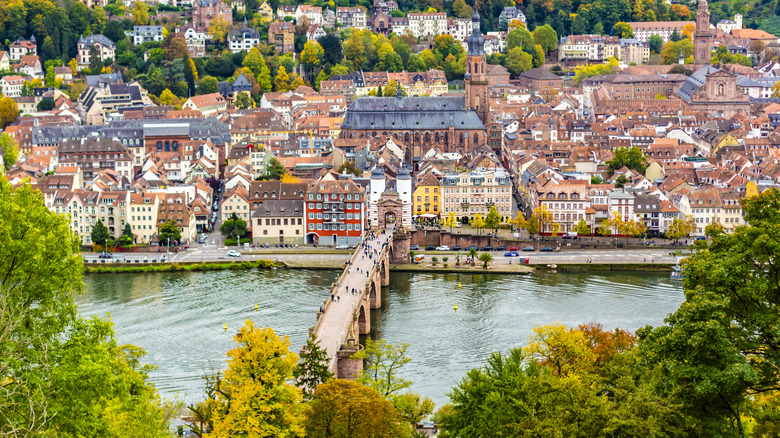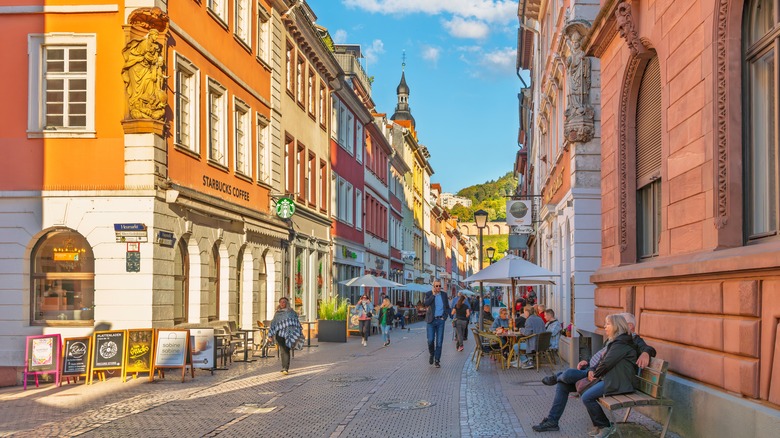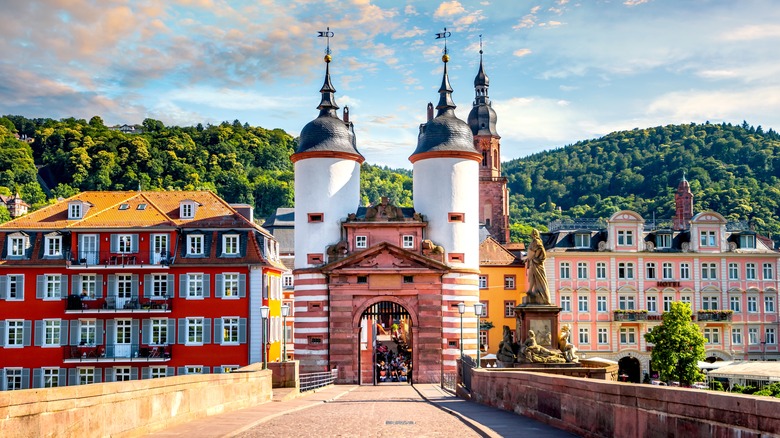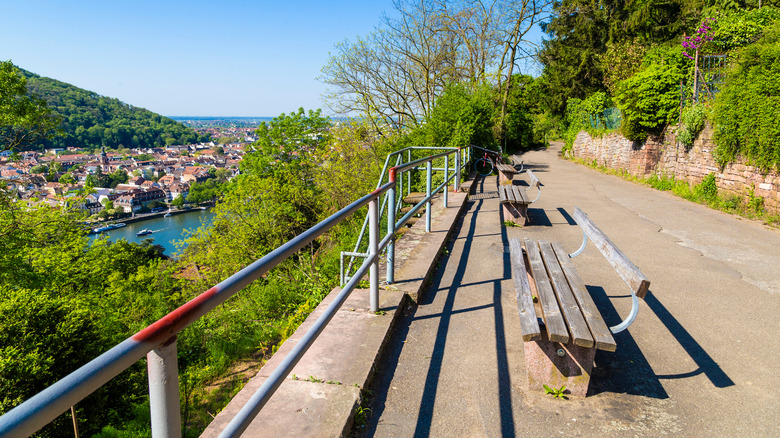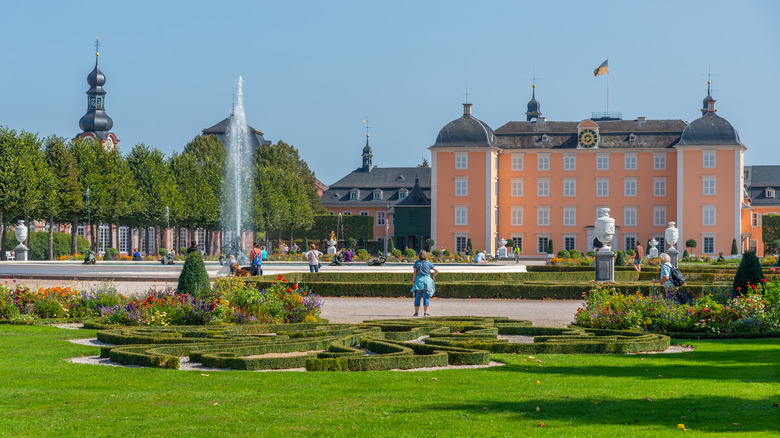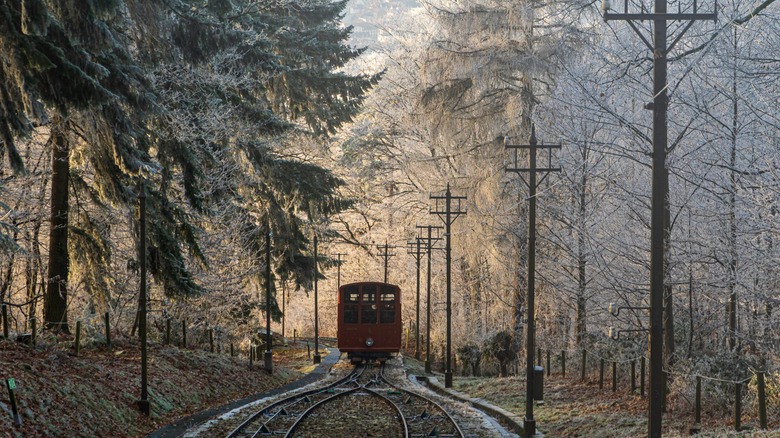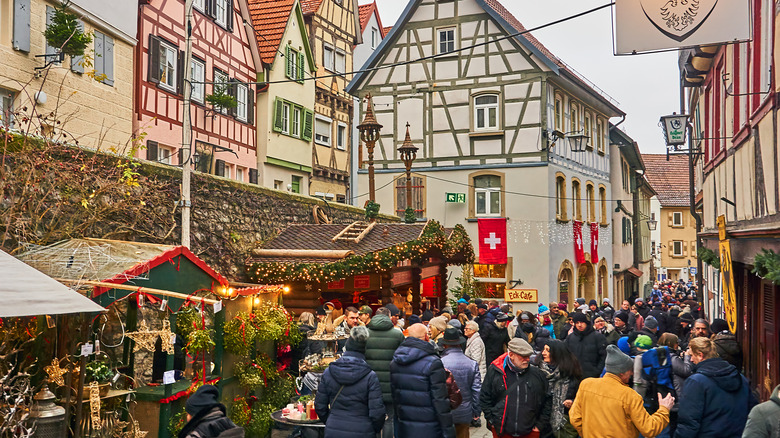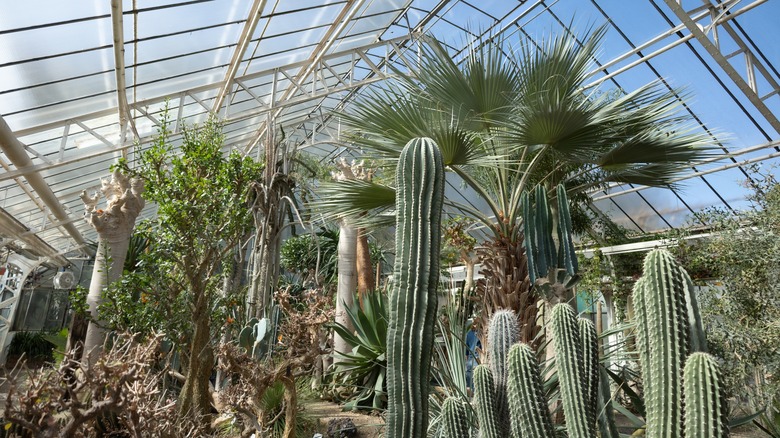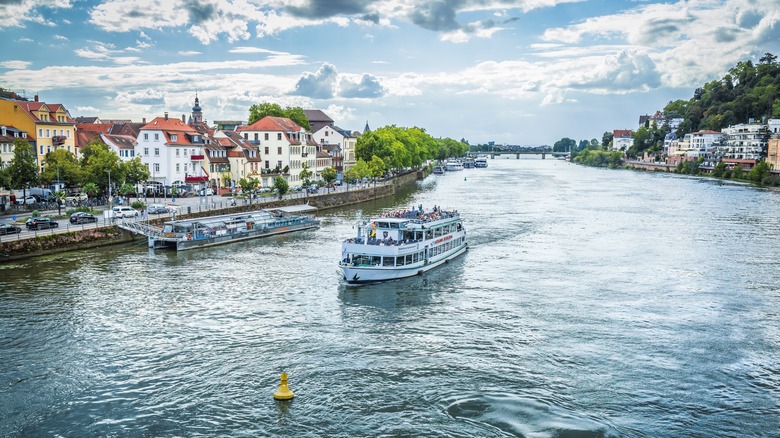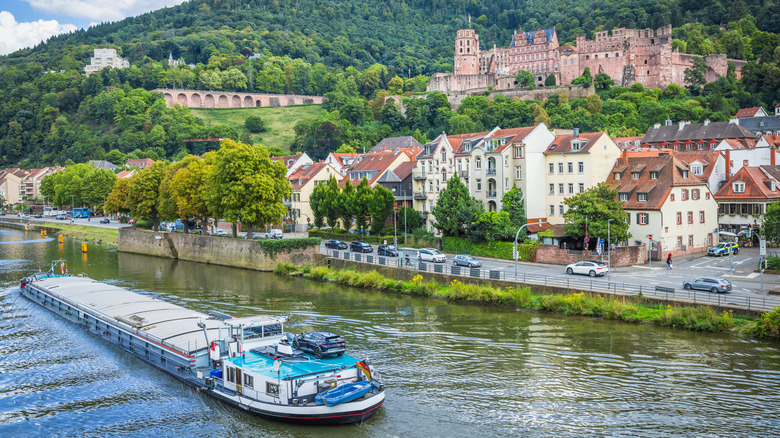Heidelberg, Germany's Top 11 Attractions Tourists Shouldn't Miss
Heidelberg, a city of around 160,000 residents, is an oasis of historic architecture, quaint streets, and beautiful views. Despite its centuries-old history, it has a youthful feel thanks to its relatively young demographic — more than a third of its residents are younger than 30 years old. This is due, in part, to being an internationally renowned college town that's home to Heidelberg University — the oldest university in Germany, established in 1386. Today, the city continues to be a bountiful arts and culture hub that's been designated as a UNESCO Creative City of Literature.
Beyond its university, Heidelberg is also a wonderful weekend destination. That said, the city also makes a relaxing and romantic basecamp for exploring the Baden-Württemberg region, which brims with nature, vineyards, inviting accommodations, and amazing cuisine. Nestled along the Neckar River in southwest Germany, it's located just about an hour by car or train south of Frankfurt am Main, and around a 1.5-hour drive or rail journey northwest of Stuttgart, one of the world's most walkable cities.
Once in town, the city center is watched over by Heidelberg Castle, a colossal fortified ruin, with a backdrop of forested hills. And because the city was largely spared from destruction during World War II, visitors can still enjoy Heidelberg's medieval charm today. Below, discover 11 attractions you won't want to miss on a visit to this beautiful area.
Heidelberg Castle
Heidelberg Castle's expansive ruins stand sentry over the city. Situated high above the old town on a hill called Königstuhl, or King's Seat, this palatial residence dates back to the 13th century. Regional noblemen — namely counts of a historical region called the Palatinate — chose the spot for its strategic position along the river, eventually transforming the medieval fortress into a grand Renaissance treasure. It also once sported an impressive formal garden known as "Hortus Palatinus," implemented in the early 1600s but now sadly left much to our imaginations. During two 17th-century wars — the Thirty Years' War and the Nine Years' War — the castle took a beating from French forces. Although partially repaired, lightning started a fire in 1764 — and, as they say, the rest is history.
A stunning castle brimming with storybook charm, Heidelberg Castle makes for an amazing photo op from the city as it peeks out above buildings. However, it's also a worthy visit in its own right. What it lacks today in opulent furnishings, it more than makes up for with its atmospheric stone walls and unique hidden passageways, or casemates, where armed defenders would have staved off military attacks. In the summer, tours are available through these centuries-old areas.
Don't miss the German Apothecary Museum, located in a basement exhibition space, which explores the history of medicine and healing during the Middle Ages and Renaissance. The collection contains around 1,000 "materia medica," from plants to minerals, and even unicorn.
Hauptstrasse and the Altstadt
Hauptstrasse is a bustling pedestrian-only artery through the old town, or Altstadt, of Heidelberg — a perfect place to start exploring on foot. A straight shot on the Hauptstrasse stretches just a little more than a mile long from end to end, making it one of the longest pedestrian shopping streets in Europe. It's a charming stroll, with a great selection of boutiques, galleries, cafes, and old churches.
Numerous other eminently explorable streets branch off of Hauptstrasse. You'll also find wonderful cobbled squares to explore, like Kornmarkt, Universitätsplatz, and Marktplatz, with its view of the castle on the hillside above. These squares, in addition to the more modern Bismarckplatz, transform into one of the most incredible Christmas markets in Europe come late November.
Heidelberg's Altstadt is also home to some remarkable landmarks, like the Heiliggeistkirche, or Church of the Holy Spirit. Visitors will also see the ornate Haus zum Ritter St. Georg, which features a distinctively carved facade in red stone dating to 1592. Meanwhile, Neckarstaden, which parallels the river, features a wide sidewalk that's perfect for watching boats cruise by. Finally, you'll want to keep your eyes peeled for the Marstall and Heuscheuer, or royal stables and hay barn — a remarkable stone structure with a recognizable round tower at the corner. A great way to get an overview and learn about the history of the area is to join a guided bicycle tour, after which you'll probably want to break for a good coffee and dessert at local favorites La Fée Bar Café or Coffee Nerd.
Church of the Holy Spirit
The centerpiece of Heidelberg's market square is Heiliggeistkirche, or Church of the Holy Spirit, which strikes an impressive figure. Surrounded by cafes — and the Christmas market starting in late November — the church stands as a proud icon amid the skyline. Before the current building was erected, a Romanesque basilica stood on the site, but the church we see today began to take shape in 1398. Its recognizable bell tower was originally built around 1515, and rebuilt once more in the 17th century with its Baroque, pear-shaped top. Furthermore, the tower also happens to be home to a wild peregrine falcon nest, which has been monitored since 1999.
The Church of the Holy Spirit is certainly worth adding to your list of the most breathtaking churches across Europe. Not only does it hold the distinction of being where the historic Heidelberg University was founded, but it also once held the greatest collection of handwritten books in Europe. Until 1623, the so-called "Biblioteca Palatina" was housed within the church. However, during the Thirty Years' War, the valuable archive was plundered and sent to Rome as a trophy, where it largely remains to this day.
Heiliggeistkirche is open and free to visit outside of service times. Inside, visitors can climb the tower via a couple hundred steps for views that make the effort worthwhile, and enjoy an amazing vantage point of Heidelberg Castle over the rooftops.
Karl Theodor Bridge
Also known as the Old Bridge, or Alte Brücke, the Karl Theodor Bridge is a beautiful stone construction over the Neckar River with amazing views of the city and its hills. Built between 1786 and 1788 by Elector Karl Theodor — a title afforded to a German prince who had the privilege of helping choose the Holy Roman Emperor — the elegantly arched crossing is made of locally quarried stone. Constructed to replace a series of wooden bridges that were much more susceptible to the elements, Theodor chose to retain the unique double-towered medieval gate that was formerly part of the city's fortified wall, ensuring the structure's link to the past.
In March 1945, near the end of World War II, the original bridge was partially destroyed when German forces blew it up along with other nearby bridges. Thankfully, reconstruction began about a year later, and the Old Bridge reopened in summer 1947.
Make sure to check out the two sculptures located on the bridge, representing Theodor and the Roman deity Minerva, goddess of the arts. From here, views of the river up toward the Altstadt and Heidelberg Castle really exemplify why this city is one of the most lovely in Germany.
Philosopher's Way
One of Heidelberg's beloved characteristics is its natural surroundings. The small city is nestled amid Baden-Württemberg's rolling hills, and one of the best ways to appreciate the landscape is on foot. Specifically, the Philosopher's Way is a beautiful marked walking path through both city and nature, along which you'll find photo ops aplenty.
The route formally starts at the northern end of the Old Bridge, across the river from Old Town. Setting off in a clockwise direction, you'll head uphill along a few residential streets before turning east onto the Philosophenweg. From there, you'll eventually wind your way into green parkland and along terraced vineyards. A number of viewpoints along the way offer spectacular views across the Neckar River, its bridges, and all the way to the Altstadt and Heidelberg Castle. Once you've finished, the path loops back down via a twisting trail called the Schlangenweg, or Serpentine Path, which runs along the river.
During the warmer months, the Philosopher's Way is a great place for would-be botanists to explore, as the southern-facing slope of Hill of the Saints (or Heiligenberg) is very sunny and sustains a wide range of plant life not found in other parts of the valley. Keep an eye out for flora one might not expect in this climate — including bamboo, palms, cypress, cherry trees, and more. There are also plenty of other trails to explore on Hill of the Saints via which you can visit other unique sites, like the ruins of a monastery called Michaelskloster, and even more elevated views from the Zollstock hiking area.
Schloss Schwetzingen
If you're looking for an easy morning or afternoon jaunt from Heidelberg's city center, Schwetzingen Palace, or Schloss Schwetzingen in German, is just the place. About 15 minutes west of the city by car, the palace is known for its glorious Rococo design and, perhaps foremost, its historic formal gardens. Before 1350, the sprawling site was home to a modest castle with a moat. However, over time, it became more attractive to regional nobility who, during the 18th century, transformed the residence into the lavish place we see today. Elector Karl Theodor, responsible for the construction of Old Bridge, was also behind reshaping Schloss Schwetzingen into the opulent palace we see today.
A wander through the estate's gardens is a trip through royal landscape design, flush with dozens of sculptures and unique buildings. Head to Theodor's favorite garden retreat, the Bath House, which was used for socializing and creative pastimes. You'll also find a (perhaps unexpected) addition to the garden in the form of a pink mosque, complete with two minarets, which rises like a confection amid the greenery.
The palace is accessible via guided tours only, which run around $14 for adults as of this writing, and are offered once in the afternoon on Saturdays, Sundays, and public holidays between March 30 and October 25. By contrast, the garden is open all year and can be explored at your own pace. Admission to this site costs around $10, and includes access to the Bath House, mosque, lapidarium, orangery, and porcelain collection.
Heidelberg Mountain Railway
The Heidelberg Mountain Railway operates a network of funicular rides up to the summit of Königstuhl, or King's Seat, providing amazing views over Heidelberg, the Neckar Valley, and beyond. Starting in Kornmarkt, in the Altstadt, a modern tram heads up to the station at the castle, before continuing onward to Molkenkur station, where passengers can enjoy panoramic views of the city and stop for a bite to eat. For those who want to extend their stay, overnight accommodations at the romantic Schlosshotel Molkenkur are also an option. To continue the journey to the top of King's Seat, visitors can transfer to a historic, electric funicular that conveys passengers to the summit at about 1,800 feet.
Both the upper and lower funicular routes run quite regularly throughout summer and winter. The lower line operates every 10 minutes, while the upper line run every 20 minutes throughout the year. During the winter, last departures start a little after 5 p.m., whereas during the summer, last departures begin closer to 8 p.m. A round-trip ticket, including all stops, costs around $20 for adults, and the fare includes entry to the Heidelberg Castle grounds. Separate fares can also be purchased if you plan to take only the upper or lower routes.
Bad Wimpfen
Germany is blessed with a number of charming medieval towns you don't want to skip when visiting Europe. In addition to Heidelberg itself, Bad Wimpfen is a picturesque town within an hour's drive to the southeast that features a lovely, walkable old town. For those without a car, it's also reachable by train in about 1.5 hours.
Located on the Neckar River, Bad Wimpfen features numerous half-timbered buildings and other structures dating to the Middle Ages — like the Wimpfen Imperial Palace, which lends a postcard-worthy backdrop with its iconic towers. The Blauer Turm, or Blue Tower, is one of the city's most recognizable icons. Constructed in the 1100s, it was intended to serve as a keep and a watchtower. For an admission fee of roughly $4, you can climb to the top for panoramic views of the town.
In addition to this, visitors can also take a guided walking tour, visit the historic town hall, and step into a number of impressive ecclesiastical buildings, like the Evangelical City Church or the Collegiate Church of St. Peter. For a museum housed inside a building that is a gem of history itself, head to the Steinhaus, or Stone House, which showcases regional artifacts dating all the way back to the Roman era and the Stone Age. Come late November, Bad Wimpfen is also home to one of the oldest traditional Christmas markets in the country, with a history that extends back to at least 1487.
Heidelberg Botanic Garden
The Heidelberg Botanic Garden was originally established in 1593 near the city's namesake castle — making it one of the oldest botanical gardens in the world. It then moved around to different spots before settling into its current location in 1915.
Maintained by Heidelberg University, the botanic garden is both a place for ongoing research and a lovely way to spend an hour or two strolling through outdoor gardens and greenhouses chock full of both native and global plant species. Spanning more than seven acres, the garden also features an impressive 43,000-square-foot greenhouse complex. Although the original structures were destroyed at the end of World War II, what visitors see today is the result of a careful postwar reconstruction and expansion project.
Nowadays, half of the building is open to the public, and visitors can see a wide array of flora that thrive in different climates. Meanwhile, the beautiful outdoor setting includes an alpine garden, perennials, ferns, shrubs and more. Altogether, the garden cares for around 5,000 species — and the best part is that you can visit all year round, free of charge. The outdoor areas are open all the time, and the greenhouses are open every day of the week except Saturday.
Take a river cruise
Many of Europe's major rivers are famously scenic, from the Rhine to the Seine to the Danube, and local riverboat companies typically offer some of the best river cruises in Europe along these routes. That said, another smaller — yet no less beautiful — waterway is the Neckar. And there's no doubt that taking a sightseeing cruise along Heidelberg's river is a picturesque and relaxing way to learn about local sites. Better yet, to get your day flowing in the right direction, you can even hop aboard a breakfast cruise organized by local tour operator, Weisse Flotte.
If that doesn't sound like your thing, there are a number of different options depending on your tastes (literally) and how much time you'd like to spend on the water. For example, one wintertime option, which runs for 50 minutes, includes mulled wine to make the experience extra cozy. Alternatively, there's also a standard 50-minute sightseeing tour.
If you'd like to make a day of it, a three-hour route called the "Four Castles Tour" sails past the — you guessed it — four castles of the nearby town of Neckarsteinach. This tour even includes a hop-on, hop-off option, so you can spend even more time exploring its different stops — like the beautiful Benedictine Neuburg Abbey, or the greenery of Neckartal-Odenwald Nature Park. If you'd prefer to drive there, Neckarsteinach is located just about a half-hour drive, or a 20-minute train ride, outside of Heidelberg.
Kurpfälzisches Museum
Also known as the Palatinate Museum, Heidelberg's Kurpfälzisches Museum showcases a wide range of archaeological artifacts, artworks, and more related to the region's history. Located along the Hauptstraße in the old town, inside the ornate Palais Morass, the Kurpfälzisches Museum especially focuses on the material culture of the city and the historical region of the Palatinate.
The museum is home to a range of centuries-old art and craft pieces, archival works on paper, artifacts of Heidelberg's history, and a diverse collection of textiles. A unique trove of artifacts from the Thirty Years' War glimpses what life may have been like in the besieging army's camps. In addition, the museum also holds an array of grave goods excavated from a number of Roman burial sites at the Heidelberg-Neuenheim cemetery. Going even further back in time, artifacts from the ancient Celtic and Neolithic periods include a wide range of remarkably well-preserved pottery, tools, weapons, and ceremonial objects.
Open every day of the week except Monday, admission costs about $4 on weekdays and $2 Sundays and public holidays. Your ticket also includes an audio guide, which is available in German, English, or Russian.
Methodology
To share the top 11 destinations in and around Heidelberg, we researched regional tourism sites like Visit-BW.com, Heidelberg.de, Heidelberg-Guide.de, Heidelberg-Marketing.de, Burgenstrasse.de, and BadWimpfen.de. For specific information about opening times, admission prices, and historical context, we consulted individual attractions' official websites, including Deutsches-Apotheken-Museum.de, Schloss-Heidelberg.de, Heiliggeist-Heidelberg.de, Schloss-Schwetzingen.de, Botgart.COS.Uni-Heidelberg.de, and WeisseFlotteHD.de.
We also gleaned a bit of additional historical information from UNESCO. Finally, to make sure we've emphasized the best experiences and attractions in the area, we referred to visitor reviews and ratings published on TripAdvisor, Wanderlog, AllTrails, Get Your Guide, and Google.
